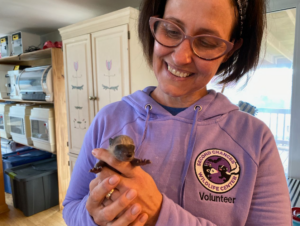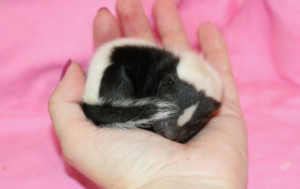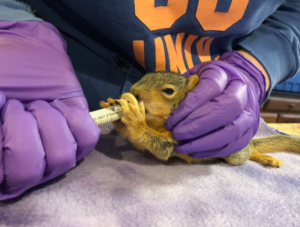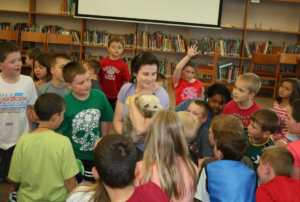Second Chances Wildlife Center Fosters Conservation and Environmental Stewardship
Writer / Annette Skaggs
Photography Provided
It all started with baby opossums. Brigette Brouillard was camping with family when, out hiking, they came upon orphaned baby opossums. Worried for their safety, she reached out to shelters and humane societies only to learn that their services did not extend to the preserving of wildlife. It was in the finding of those animals that Brouillard and a handful of knowledgeable and erstwhile volunteers began the facility known as Second Chances Wildlife Center. 
Spread across 23 acres, the Second Chances mission is to foster compassion, conservation and environmental stewardship through education and wildlife rehabilitation. Their mission is accomplished in two ways – first, environmental education programs, which not only teach facts, but also foster compassion and excitement for nature and environmental sustainability, and second, the rescue, rehabilitation and safe release of orphaned, injured or displaced native wildlife.
The educational component of the wildlife center helps to connect humans to the needs of the wildlife that surround us each day. Brouillard shares that the soonest we can share our knowledge and experience with young people, the better the chances they will be good stewards of our environment, including wildlife.
Having been a school teacher for 18 years and also worked with the Louisville Zoo for 20, Brouillard and her trained volunteers often travel within a two-hour radius within Kentucky and southern Indiana with classes such as While You Were Sleeping, Wildlife and Waterways and Awesome Opossums. If you are looking for a more robust educational experience, Second Chances also offers a compendium of classes that can take place over the course of weeks, or you can choose to bundle the five courses in the same week. All materials are included with the classes, and oftentimes an ambassador animal will accompany the teacher.
Ambassador animal? Yes, Second Chances has a select group of animals that serve as program ambassadors. You may have the opportunity to get to know one of the four opossums that have residency at the sanctuary – Peaches, Cinnamon, Nutmeg or Clove. Have you ever wanted to see a bat up close? Currently there are 17 brown bats, 10 Egyptian fruit bats, and two eastern red bats named Pumpkin and Pepperoni, who reside at the compound and very well might accompany the instructors for a session.
Speaking of Pepperoni the bat, she has a book written about her, Pepperoni: The One Winged Bat. As if Brouillard was not busy enough, she wrote an adorable true story about Pepperonis journey to the sanctuary, and how she learned to adapt to her new way of life. With illustrations by Lori Sargent, the book is dedicated to Brouillards children, Kyle and Molly, and can be found on Amazon.
Besides bats and opossums that take up permanent residency, there are other animals on site including Juan Carlos and Blackjack the raccoons, one groundhog who goes by the name of Major, Apache and Rocket the African sulcata tortoises, Blu and Amelia the flying squirrels, Rawlings the red fox, Livia and Spartacus the box turtles, Danica, Rudy and Brooks the skunks, and Bougie the beaver.
When asked why these animals are on permanent residency, Brouillard shares that for many of them, injuries and inability to survive in the wild precludes them from being released.
I have an outstanding group of volunteers from all kinds of different walks of life – vet techs, nurses, teachers, techno wizards, bankers, public servants, etcetera, Brouillard says. These dedicated folks travel as far as Cincinnati, Fort Knox and Goshen to help care for and nurture these animals, as well as assist with the curricula. Some of my volunteers have been with me for as long as nine to 11 years. We ask a lot of our team in that they must commit four hours a day, and we offer various shifts to accommodate those schedules. These invaluable people are here to assist with animal intake, cleaning and maintaining the habitats and/or cages, feeding and watering the animals, allowing the animals recreation and assimilation, and serve as docents for on- and off-campus classes. Id be delighted to have 20 more.
And what about those enclosures – are they natural? Man-made? With conservation of these animals, we try to get their surroundings as close to what their natural habitat would be, Brouillard says. Our outside enclosures are rather large, 18x20, and we include tree limbs, rocks and other woodland accoutrements that youd expect in the outdoors. We also have animals that reside indoors and that could be for medical or rehabilitation reasons.
Of course, Brouillard and her team did not go into this endeavor blindly. It is a rigorous and painstaking process to run a facility such as Second Chances. There are a lot of courses and certification processes that need to take place before we can legally operate, Brouillard says. Through the Kentucky Department of Fish and Wildlife there is a gauntlet of class clinics, labor works, homework and tests that one has to go through to be licensed. Our sanctuary goes through the same procedure as the Louisville Zoo does. We have an annual inspection that includes lengthy and detailed accounting of all animals that have arrived and been let go of at the sanctuary. Our permanent residential animals are licensed, just like the animals at the Zoo. So, we absolutely have the passion and drive to serve the wildlife in and around our area.
What about the upkeep of the animals and the property? Second Chances is a 501(c)(3) not-for-profit organization, where we receive 80% of our operating costs from individual funding, Brouillard says. Recently we participated in the Community Foundation of Louisvilles Give for Good campaign and did well, but we absolutely rely on donations and class fees. For example, it costs $231 for a bucket of baby formula that we feed to our babies.
We also spend a small fortune in other foods too, such as cat and dog food, fruits and vegetables, yogurt, fish, jarred baby food, mealworms and mice, Brouillard continues. We also go through so many paper towels and baby wipes, like you would not believe. Of course, there are the other things such as vet bills, utilities, property upkeep, and medicines and vaccinations. We make sure that all our animals are vaccinated against diseases such as parvo and rabies, as is required by law.
What does one do upon coming across an animal that may be in need? Like I had encountered before I began Second Chances, many well-meaning and kind people do not have an inkling of the resources that may be out there to take care of wildlife that may be in need, Brouillard says. There are often calls to the shelters, animal hospitals and pet stores, but luckily many of these places know to direct calls regarding wildlife to sanctuaries like mine now, and we do the same if it relates to an animal beyond our abilities to assist. It is not uncommon that our office receives 50 calls a day regarding any array of animals. I believe we have received about 3,000 so far this year. The months of March through October seem to be the busiest for us, as those are prime baby months. Things seem to slow down just a hair in the winter, but we are still busy.
animal hospitals and pet stores, but luckily many of these places know to direct calls regarding wildlife to sanctuaries like mine now, and we do the same if it relates to an animal beyond our abilities to assist. It is not uncommon that our office receives 50 calls a day regarding any array of animals. I believe we have received about 3,000 so far this year. The months of March through October seem to be the busiest for us, as those are prime baby months. Things seem to slow down just a hair in the winter, but we are still busy.
Along with Brouillards talent for treating animals as well as teaching about the animals themselves and conservancy, she adores having the ability to reach out and experience conservancy in person. Recently she and a small group of environmentalists traveled to Belize and the Galápagos Islands, where they assisted in the tracking of endangered sea turtles. Having the opportunity to watch these turtles come to the beach, dig out a nest that many of us were able to assist with, watch as this mother turtle lays hundreds of eggs, covers them and goes back out to sea, is life changing, she says with a smile, adding that she is currently planning for another trip soon.
If you are interested in any of the programs offered by Second Chances, or would like to volunteer or donate, please feel free to go to secondchanceswildlife.org. There you will find a robust website filled with information about their classes and programs. Second Chances is a pathway to help those animals in need, and teach us how to be better to ourselves and our wildlife friends.




